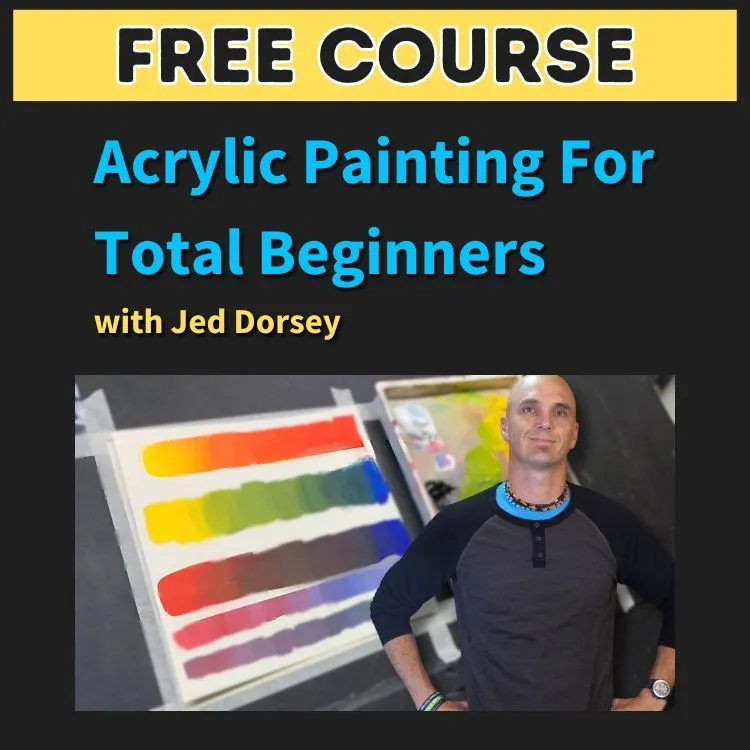Learning to Paint: 5 Things You NEED to Know

How to Start Painting
If you're someone who wants to learn to paint, this article is for you. We cover the important inner game of getting yourself to begin and the practical game of buying the right supplies. If you follow these tips, you can experience the excitement and sheer joy of painting.
Why It’s Hard to Start
Here's the truth: many, many people who want to start painting never actually do it. They want to. They might even feel like they need to. And yet, they allow their panic, fear of failure, and bumps in the road to talk themselves out of painting.
A lot of people have the desire to paint, but don't know where to start. They get confused looking at the variety of brushes, colors and mediums that are available. When the beginner stands in the aisles of an art supply store and stares at the endless amounts of supplies and thinks of all the possible projects, they panic. Better to stick with what you know. Better forget this whole art thing.
Others want to create art, but are scared they won't be good enough to create something beautiful. Fear holds them back. That fear of failure blocks them from allowing themselves the room to grow, learn, and have fun creating. What if I make something awful? What if I’m too old to ever get good? What if I’m just not artistic enough?
Others jump in courageously, but give up after a short time due to the frustration of not knowing how to move forward. They hit a wall, and all the fun gets sucked out of the room. They don’t want to do endless practicing to break through a plateau. They just want to effortlessly paint and get better and better.
I don't want that to be you. And you don't either, right? :-)
No matter what fears you have, you can learn to paint. And it doesn't have to be intimidating or cost a fortune. Painting doesn't have to be a super serious, intimidating thing. The truth is that if you can write your name, you have all the physical skill you need to be a painter. Yes, there are things to learn, but if you have the desire, you can do it!
Why You Can (and Should) Paint
Here's another truth. You are creative. You may not always believe that about yourself, but it's true. The problem is that, for a lot of people, that artistic part of them lies dormant. It hasn't been encouraged or fanned into flame. I want you to be one of the people who finds their way, because I believe you are creative. And what’s more, being creative is an important gift — both for you and the world around you.
Once you get your creative juices flowing, once you unleash the painter inside of you, you’ll find you have an endless amount you want to say and do with a brush and canvas.
There is no more exhilarating feeling than showing up to your studio with an idea burning, that you just have to paint. Once you're done, you can step back and see your work pay off.
But to get there, you have to start painting.
Tips to Start Painting
My goal here is simply to help you along your creative journey — hopefully avoiding some common pitfalls. Does that sound good? Let’s cover the essentials:
- Keep it simple
- Find what inspires you
- Don't be surprised by fear
- Always have fun
- You CAN do it
Keep it Simple
The best gift you can give yourself when you’re just starting out is to relax and not expect anything. Start small, start simple. Bring no expectations, make no demands on yourself. All you need to do is paint something — anything. That isn’t so complicated, is it?
In fact, go into your first painting with only one goal: put paint on the canvas. At the end of the session, your painting doesn’t have to resemble anything. All you need to do at first is paint.
After that, gradually increase the difficulty. If you painted an apple, try painting the shadow a little better this time. It's a baby step, but that's how your paintings get better. You just have to begin simply.
Find What Inspires You
Look at art you love. That’s one of the most important practices in painting. You need to train yourself to know what you like and why, and that process requires looking at paintings.
Borrow art books from the library that jump out at you. Make Pinterest boards. Use Instagram to find interesting artists.
That’s a major part of inspiration, but the other side is finding inspiration in everyday life. Do you love hiking? Make sure to hike whenever you can. Do you like family time? Don’t put it off. Do what you love and open yourself up to the experience.
When inspiration hits you, it will provide you with those golden ideas, those bolts from the blue. And then, you won’t be able to wait to get back to painting.
Don’t Be Surprised by Fear
No matter what creative activity you can think of, the biggest block is fear. Fear tricks you into thinking you can’t do something. It gets you so wound up in what ifs that you can’t follow through on why nots.
Because we’re human, we can assume that at some point — and maybe fairly often — we will experience fear. We can’t prevent it, but we can be prepared for it when it comes.
Fear can be tricky, it can disguise itself as other feelings. When you go to paint do you suddenly get tired? Do you feel like doing the dishes is the most pressing need in the world? Would you rather snack, text, nap, or do about anything else?
What you’ll find is that underneath those feelings is usually fear of some kind. Painting is playful and fun, but when we make expectations of ourselves, it starts to feel like a chore. What’s worse, we start to feel like we could fail those expectations, so better to not even try.
Some things help, like meditation, a healthy lifestyle, and other things you know you should be doing already. Other than that, you need to reset and paint something that you promise yourself nobody will ever see. Put your brush in paint and then put it on the canvas — that’s all you gotta do!
Always Have Fun
That connects to this next point, which I think is one of the most important. In your painting, let fun be your guide. Don’t paint the sunset even though you don't want to because you think artists are supposed to paint sunsets. Don’t paint a portrait because you think that’s what people expect.
If it isn’t fun, don’t do it.
Pick your projects because it seems like a good time. You have nothing to prove. You are already valuable and worthy of love. Painting doesn’t change that. What painting does is enrich your life, but only if you actually paint. And the only way to paint is to have fun while doing it.
You CAN Do It
This is the mantra to repeat over and over again.
Many who start painting later in life, or try to get back into painting after years away, find it difficult to jump in — there’s dinner to cook and bills to pay and the kids made a mess in the living room. Others start very young but feel that they don’t have mentors around to guide them.
Whatever your situation, you CAN do it. If you can’t dedicate three hours a day to painting, dedicate twenty minutes. If you don’t have someone to teach you, watch YouTube tutorials.
Supply Tips
All of the above is important, but without a canvas, brushes, or paints, you’ll find it very difficult to create a painting. As we mentioned before, art supplies can be intimidating at first. But really, the basics are pretty simple. And remember: if you make a mistake, it’s not the end of the world!
Paints
Beginning painters should always choose acrylic paints, rather than oils. Acrylic paints are straightforward: you pick the color on the tube, squeeze it out, and put it on the canvas with your brush. Oils can become tricky chemistry challenges — no thank you!
In short, acrylic paints are:
- Easy and intuitive
- Quick drying
- Inexpensive
- Easy to travel with
- Non-toxic
- Durable
Canvases
The heading above says canvases, but don’t let your imagination stop there. If you have acrylic paints, you can use many different surfaces to paint on, like wood. But most people want to paint on a canvas, these are made for painters and have served them well.
You will find that traditional stretched canvases are expensive. When beginning, look for canvas pads. These are spiral bound pages that you can paint on, like a notepad but for painting in. They aren’t inexpensive or affordable — they are downright cheap, and we love them for that.
Brushes
There are several kinds of brushes, with their names coming from the shape of the hairs. You have fans, filberts, detail rounds, and more.
Of course, you can start by purchasing a beginners set, but if you don’t want to buy a set, start with a round and flat brush. These two will typically be the most important to have. After you get comfortable with them, explore finer points for intricate detail work.
Easels
Today, there are many affordable options for easels. But when you are first starting, these should be your lowest priority. However, there will come a time when you get tired of bending over your canvas, getting in the way of your own light.
Once you decide to step into the market, focus on how you actually paint. If you prefer to go out and paint, buy travel easels. These fold up into a suitcase-shaped package that makes for easy, on-the-go painting. But be honest with yourself — if you don’t do that, save your money.
If you prefer sitting down, there are many easels that allow you to set up at a table, a convenient and space-saving option for some.
Final Thoughts
The long and short of it is you can start painting. It doesn’t have to be difficult, and you already have the most essential elements in you.
With the right attitude and a few supplies, you can start painting right now. It’s a fun, rewarding experience, and it’s available to you. All you have to do is begin.




